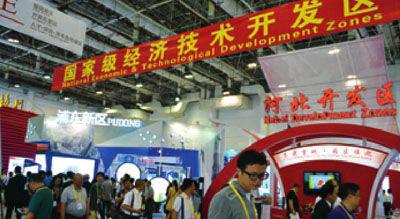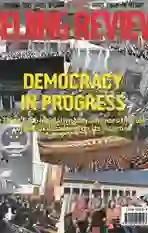The Twilight Of the Zones
2014-10-11ByZhouXiaoyan
By+Zhou+Xiaoyan
Three decades ago, a vast saline area to the southwest of downtown Tianjin lay idle. This once discarded and infertile land, situated near the Bohai Sea, soon became the very spot that has borne the most economic fruit in the north China municipality. All of this can be attributed to the Central Governments decision to build an economic and technological development zone (ETDZ) there in 1984, in a bid to further open up the country to the outside world.
ETDZs are industrial parks where businesses, especially foreign businesses, can enjoy preferential policies in taxation and favorable prices for land usage.
“The ETDZ in Tianjin has become the strongest driving force behind the citys economic development. It has 5,282 foreign businesses from 88 countries, among which 89 are listed on the Fortune Global 500. Over 4,000 foreigners and 500,000 Chinese people live and work in the zone,” said Xu Hongxing, Chairman of the Administrative Committee of Tianjin ETDZ, which is ranked No.1 in terms of comprehensive competitiveness among all ETDZs in China.
Tianjins model was later duplicated across the country. To date, 215 national-level ETDZs have been set up, collectively playing a major role in creating jobs, attracting foreign investment and generating tax revenues. Xu said that ETDZs have been an engine for Chinas economic growth for the past three decades.
However, thirty years after their inception, ETDZs are facing challenges related to upgrade and transformation.
“The primary functions of ETDZs in China should be transformed from simply pursuing speed to quality, from government-led to market-led growth, from homogeneous competition to differentiated growth patterns and from focusing on infrastructure construction to the establishment of a favorable soft environment,” said Chinese Vice Premier Wang Yang, during his keynote speech at the International Investment Forum, a sideline of the 18th China International Fair for Investment and Trade(CIFIT), held in Xiamen, southeast Chinas coastal Fujian Province on September 8.
A powerful engine
In 1984, the Chinese Government decided to establish ETDZs in Chinas eastern coastal cities to expedite the countrys reform and opening up.
From 1984 to 1988, 14 national-level ETDZs were established, including those in Tianjin, Dalian of northeast Chinas Liaoning Province, Qinhuangdao of north Chinas Hebei Province and Qingdao of east Chinas Shandong Province.
“ETDZs enjoy the most effective and convenient system in China. When they were first established, they were mainly designed to attract foreign investment, so its very important to have a globalized investment environment, including an efficient and service-oriented government, a fair market, sufficient human resources and good educational and medical environments,” Xu said.
Later, the national program was extended to the less developed inland cities and then to west China.
“Chinas ETDZs have become the backbone of the countrys economic growth and a leading force in opening up to the world. Last year, foreign investment to ETDZs accounted for nearly one fifth of the total foreign investment in China and the GDP generated by those ETDZs accounted for one eighth of the national total,”said Vice Premier Wang.
Gao Hucheng, Chinese Minister of Commerce, said national-level ETDZs are spearheading Chinas economic growth in many ways.
“They are leading the country in attracting foreign investment, in creating industrial clusters, in technological innovation, in green development and in realizing more balanced development between different regions,”Gao said.
Zeng Xiwen, Vice President of Unilever North Asia, said that in China, a great number of feasible reform measures were issued after carrying out pilot reforms in ETDZs.
“More importantly, ETDZs have fostered an array of people who possess the mindset for reform,” Zeng said.
Time to change
Vice Premier Wang said China still attaches great importance to foreign investment, but the focus has now changed.
“Although China now has sufficient investment, we will never overlook the function of foreign capital. In the future, instead of simply attracting investment, China will pay more attention to the introduction of advanced technologies, management experiences and a global talent pool,” Wang said.
Yang Zhiping, Chairman of the Administrative Committee of Suzhou ETDZ, said innovation is the key to ETDZs future development, including institutional innovation, technological innovation and innovation in government administration.
According to Yang, the population of the Suzhou ETDZ has reached 1 million, which requires the region to change in at least three aspects.
“First, the growth pattern should be changed from pure processing to high-end manufacturing. Second, a transformation in social management is needed. Among the 1-million population in Suzhou ETDZ, 600,000 people are migrant workers. The issue of how to provide jobs for so many people and how to manage a society with so much mobility is a tough one. Finally, administrative committees of ETDZs should offer more efficient and more convenient services to enterprises, accept supervision from the general public and make scientific decisions,” Yang said.
Yang also said ETDZs should become more selective when choosing investment projects.
“When ETDZs were first established, they were willing to attract foreign investment from any available source. But now, things have changed. Most ETDZs prefer higher value-added businesses instead of processing factories. Meanwhile, ETDZs are trying to foster local firms to create a healthier business environment,”said Yang at a sideline of the 18th CIFIT.
When evaluating potential investors, the investment value shouldnt be the only important index, Yang said.
“The matter of whether or not the investment projects are in line with Chinas laws and regulations, industrial policies and environmental requirements needs careful assessment. ETDZs should also factor in whether business headquarters and research and development teams will be established in ETDZs,” Yang suggested.
National-level ETDZs have upheld the principle of “creating top-notch investment environment with international standards,”said Clement Hung, Chairman of Deloitte China. He maintained China could learn from other countries experiences in building industrial parks.
“First, diversified sponsors can promote rapid development of industrial parks. In developed countries like the United States and Europe, ETDZs are mainly created by the market, while in China, national ETDZs are mainly constructed with government funds. Second, a more diversified management team can improve the efficiency of the investment environment. Chinas ETDZs are usually managed by an administrative committee, while in foreign countries, there are several different ways to manage an industrial park, such as being led by research teams from universities or being jointly managed by the government, the market and society. China should explore more ways to better manage ETDZs,” said Hung during the 18th CIFIT.
Xu said some ETDZs continue to rampantly expand their territory and use low-cost advantage to woo investors. “Some even fight each other on preferential policies and government subsidies,” Xu said.
“That kind of development model cant be sustained. ETDZs should encourage businesses to upgrade their production technologies with the end goal of realizing greener and higher value-added production,” Xu said.
